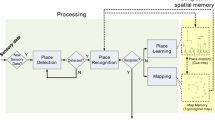Abstract
A memory-based system for autonomous indoor navigation is presented. The system was implemented as a follow-midline reflex on a robot that moves along the corridors of our institute. The robot estimates its position in the environment by comparing the visual input with images contained in its memory. Spatial positions are represented by classes. Memories are formed during a learning phase by encoding labeled images. The output of the system is the a posteriori probability distribution of the classes, given an input image. During performance, an image is assigned to the class that maximizes the probability. This work shows that extensive use of memory can reduce information processing to a simple and flexible procedure, without the need of complicated and specific preprocessing. The system is shown to be reliable, with good generalization capability. With learning limited to a small part of a corridor, the robot navigates along the entire corridor. Furthermore, it is able to move in other corridors of different shape, with different illumination conditions.
Similar content being viewed by others
References
Aste M, Caprile B (1992) Learning autonomous navigation abilities using radial basis functions networks. Proceedings of Intelligent Vehicles 1992, IEEE, Detroit, June 29–July 1
Bellutta P (1991) Basic robot utility technical reference manual. IRST technical report 9112-16
Braitenberg V, Schüz A (1991) Anatomy of the cortex. Statistics and geometry. (Studies of brain function, vol 18). Springer, Berlin Heidelberg New York
Knuth DE (1981) The art of scientific programming, vols 1,3. Addison-Wesley, Reading, Mass
Nelson RC (1991) Visual homing using an associative memory. Biol Cybern 65:281–291
Poggio T (1990) A theory of how the brain might work. Cold Spring Harb Symp Quant Biol 55:899–909
Poggio T, Stringa L (1992) A project for an intelligent system: vision and learning. Int J Quantum Chem 42:727
Pomerlau DA (1991) Efficient training of artificial neural networks for autonomous navigation. Neural Comput 3:88
Stanfill C, Waltz D (1986) Towards memory-based reasoning. Commun ACM 29:1213–1228
Stringa L (1992) Il Progetto Maia. Scienze 290:86–97
Stringa L (1990) S-nets: a short presentation. In: Caianiello ER (ed) Proceedings of the second Italian workshop on parallel architectures and neural networks. World Scientific, Teaneck, NJ, pp 177–184
Author information
Authors and Affiliations
Rights and permissions
About this article
Cite this article
Crespi, B., Furlanello, C. & Stringa, L. A memory-based approach to navigation. Biol. Cybern. 69, 385–393 (1993). https://doi.org/10.1007/BF01185410
Received:
Accepted:
Issue Date:
DOI: https://doi.org/10.1007/BF01185410




